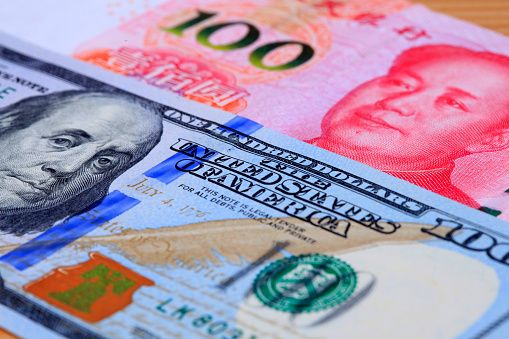Bloomberg Barclays Indices said it plans to add Chinese renminbi-denominated government and policy bank bonds to the widely-tracked index. They will be phased in over a 20-month period beginning April 2019.
The index is expected to include 386 Chinese bonds and represent 5.49% of the $53.7trn-worth index, according to data from the end of January. The adjustment would make renminbi the fourth-largest currency component, after US dollar, euro and Japanese yen.
Matthews Asia estimates $100bn will flow into China’s bond market from passive alone.
“This scaling-in period is longer than typical and is meant to allow investors time to put in place any administrative and operational requirements,” says Matthews Asia portfolio manager Teresa Kong.
Chinese corporate, other government-related and securitised debt is not entering the index for the moment, representing an additional 45% of the Chinese debt market.
Nevertheless, China will be about the size of the UK in the Bloomberg Barclays Aggregate Index, accounting for 5%, compared to 43% in the US dollar, 22% in the euro and 17% in the Japanese yen.
7IM senior investment manager Peter Sleep says: “For investors in [Bloomberg Barclays] Global Aggregate ETFs and funds, this will not be a huge change, although it may be a welcome minor dilution of the US dollar, Japanese yen and euro.”
Emerging market index
Bloomberg Barclays Indices is the most widely used fixed income index provider, but Sleep says inclusion in the JPM Emerging Market Bond Index, where they would face a 10% increase in the capped index, would be more significant for markets. If it were in an uncapped index that weighting could reach 35%.
“China’s inclusion in the EM indexes, hard currency and soft currency, could cause a major dislocation in the market in a manner akin to cuckoo chick displacing the other chicks from a nest,” says Sleep.
JP Morgan told sister publication Portfolio Adviser it does not comment on potential inclusions in its indices.
China has been under review for inclusion in the JP Morgan Government Bond Index-Emerging Markets Global series since March 2016.
In addition to the Global Aggregate Index, Chinese local currency debt will also be included in the Bloomberg Barclays Global Treasury and EM Local Currency Government Indices beginning April 2019. Bloomberg will create indices excluding China for index users who wish to track the original benchmarks.
Gordon Ip, chief investment officer for fixed income at Value Partners, sees it as a potential catalyst prompting other major fixed income indices, namely the Citi World Government Bond Index (WGBI), to include China onshore bonds.
“The development is going to take some time but the inclusion is positive to the onshore market in the long run,” Ip said.
He noted that the main challenges in China’s onshore bond market have been a lack of liquidity and a burdensome requirement involving pre-funding a trade.
Adrian Lowcock said China will eventually become its own asset class.
“You’re already seeing some institutional GEM funds ex-China. It won’t be long before China is more than 60% of the emerging markets index and therefore it needs to be separate. Once it starts to hit 20 to 30% you’ll start to see these products ratchet up,” Lowcock said.
Diversification and yield
Luc Froehlich, Fidelity’s head of investment directing for Asian fixed income, says to date, China has been largely absent from the portfolios of foreign bond investors.
“This change will therefore help redress the imbalance of global funds toward the existing core markets of US dollar, Japanese yen and euro, and will improve their diversification and yield potential,” Froehlich says.
“While the addition of these securities will be phased in gradually from April 2019, it will now be a race for asset managers to ensure they have sufficient coverage and expertise in place.”
In the first three quarters of 2017, foreign investors accounted for about 2% of China’s RMB 60trn bond market, according to data from the China Central Depository and Clearing Company.
Kong says they consider China bonds are attractive not only from a yield perspective, but also from a currency appreciation standpoint. “Given their low historical volatility, we have found that they provide attractive risk-adjusted returns as well,” Kong says.
Economic hard power
Lyxor Asset Management head of ETF strategy for Northern Europe Adam Laird said the inclusion “makes sense” as China moves to liberalise its economy and open access.
Foreign investors were first able to access bonds and equities in mainland Chinese exchanges through the Qualified Foreign Institutional Investor mechanism, a quota programme that launched in 2002.
However, it has ramped up efforts to open its markets in the last couple of years. In 2017 it launched the Bond Connect, another quota programme, and allowed foreign investors to trade onshore deliverable foreign currency exchange. In June, MSCI announced it was introducing 222 China A large cap stocks to its Emerging Market Index, representing about 0.73% of the total.
Sleep says Xi Jinping announced that China aimed to become a fully developed nation by 2049, at last year’s 19th National Congress.
“Becoming a part of the international financial system, where its currency and bonds are held as reserve assets by central banks worldwide, is very much a part of China taking its full place in the world and will add to its economic hard power,” Sleep says.







